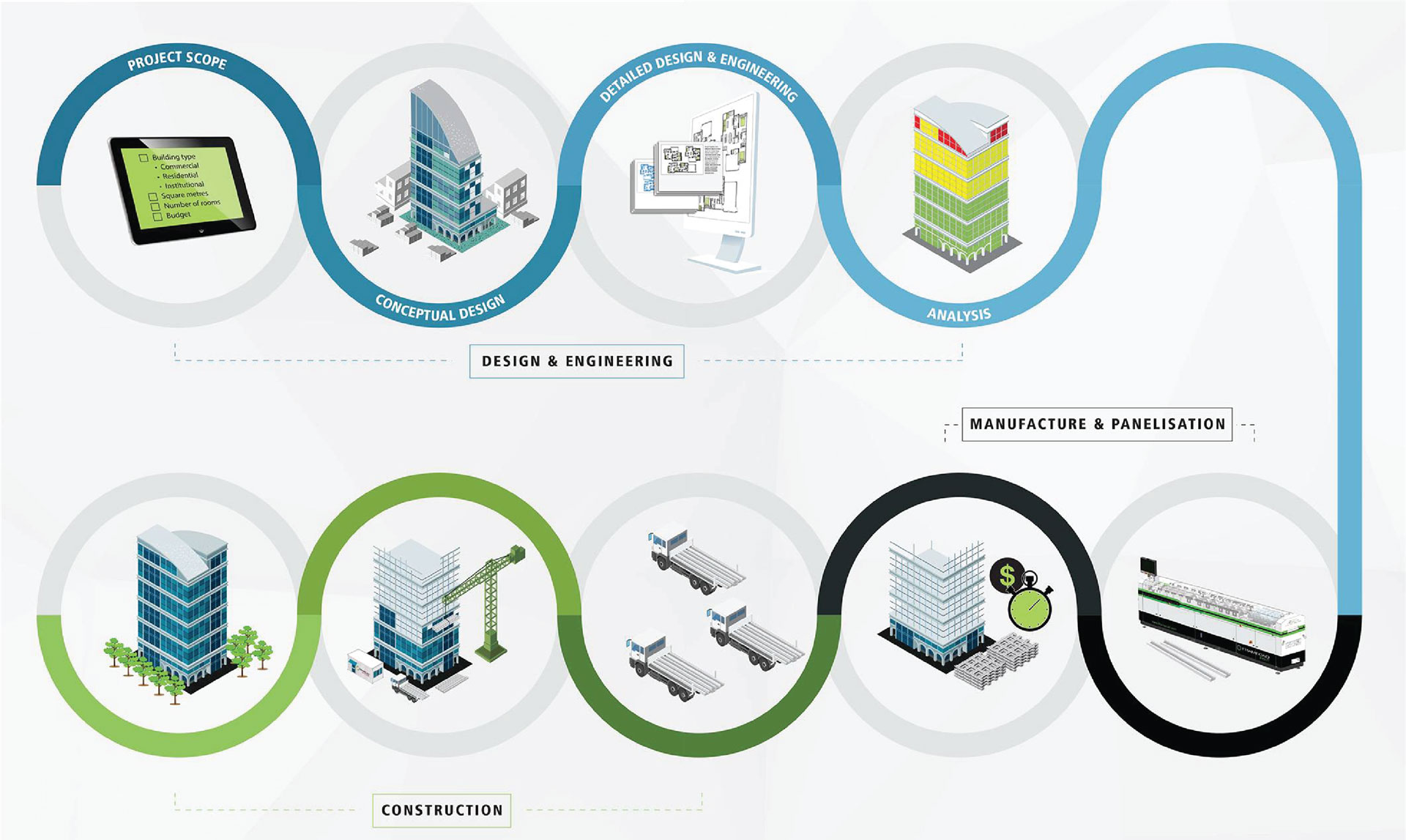LGSF Technology
Light Gauge Steel Framing (LGSF) is a modern construction method using cold-formed steel sections. It is suitable for fast, durable, and precise construction across various building types.
What is Foam Concrete?
Foam concrete is a lightweight, flowable cement-based material filled with air bubbles. It offers good thermal insulation, load distribution, and speed in construction.
Why Combine LGSF with Foam Concrete?
- Rapid, dry build: Foam raft cures fast and eliminates bricklaying—cutting water use and waste.
- Seismic-ready & strong: LGSF + foam base absorb shocks; system is lightweight yet robust.
- Comfort built-in: Multi-layer walls with insulated foundation deliver thermal & acoustic comfort.
Structural Specifications
- Foundation & frame: 200 mm foam raft + 100–150 mm RCC slab with steel framing.
- Envelope & insulation: Fiber cement or ACP panels; glass wool between studs for thermal/sound comfort.
- Roof & finishes: Galvalume or PUF panels; gypsum interiors and weather-resistant exteriors.
Compared to Traditional Construction
- Faster, leaner delivery: Up to ~50% quicker and no heavy formwork—lower labor/resources.
- Lighter seismic load: Lightweight system reduces earthquake impact on the structure.
- Comfort & suitability: Better thermal/sound insulation; ideal for remote, hilly, fast-track sites.
Ideal Alternative Construction Technology
- Hotels and resorts
- Farmhouse or mountain retreat
- Commercial buildings
- Hospitals, schools & colleges
- Rooftop extensions
- Pods and cabins
- Portable structures
- Warehouses
LGSF – High‑Precision, Sustainable, and Fast Construction
LGSF Delivers:
- A viable alternative to traditional construction.
- Fast and predictable outcomes.
- Energy efficient and environmentally friendly.
LGSF Design
Wall Cladding Materials
- Fiber Cement Board / Planks
- Cement Particle Board (Bison)
- Knuf Aquapanel
- Aluminium Composite Panel (ACP)
- Many other cladding options available
Floor Options
- Floor joists & decking sheet with concrete
- Fiber cement board (18 or 24mm)
Roof Options
Pitched:
- Fiber Cement Board & galvalume sheet or Shingles
- PUF Sandwiched panel
Flat Roof:
- Decking with concrete
Insulation
- Rockwool or Glasswool
LGSF Typical Profiles
89mm / 150mm (Thk 0.7 to 2.0mm)
Possible Configurations
100% LGSF or HR/LGSF Hybrid
Advantages
-
Faster Construction
upto 50% savings in time -
Long building life
uses galvanized steel -
Environmentally friendly
-
Dry Construction
does not use water -
Better thermal performance
by using insulating material
LGSF Suitable Building Types
G+3 buildings can be constructed using 100% Light Gauge Frames, additional floors can be constructed using a hybrid HR/CR construction.
-
Office / Commercial buildings
-
Residential
-
Modular / Pods
-
Industrial - Other
Comparison with conventional construction
| Brick & RCC Construction | LGSF Construction |
|---|---|
| Quality of construction varies as materials sourced from different vendors. | All materials are of uniform quality. |
| Huge transportation costs as all materials are heavy. | Huge savings in transportation costs as LGSF construction is 1/10th weight of that of brick wall. |
| Uneven surface requires more plastering material and reduces carpet area by 25%. | Straight finished surface do not add up extra plastering materials and reduces carpet area by only 10-15%. |
| Brick walls are more prone to shrinkage cracks. | Dry walls do not experience shrinkage cracks. |
| Wet construction which is time consuming and involves curing at various stages. | Dry and fast construction and no curing needed. |
| Life of the building and durability using CFS framework. | Expected life span of 100 years or so whilst durability is subject to 'abuse by user'. |
| Waterproofing and patches on walls. | The method/material used and workmanship takes care of these issues. |
| External and internal finishes. | Treatment using 'stucco', tiles, stones, paints etc works well on the cladding and have cleaner lines than brick walls. |
| Hollow sound/sound transfer in wall structures. | Filling the cavity with Rockwool Insulation or CLC takes care of the STC, above the codes. Floor 'heel sound' transfer can be treated with usage of acoustic lining on floor before tiling. |
| Insulation leading to energy savings. | The infill material and has a substantial improvement over the brick wall. |
| Door and window finishes. | Better due to accuracy of openings. |
| USPs and weaknesses for DRY WALL Constructions. | Time factor and increase of carpet area being USP, whilst weakness is that designs need to be frozen before starting detailing and execution. |
| CFS framework construction more expensive than RCC construction. | Under present market prices, the direct construction costs are at PAR, but CFS could lead to a higher ratio of Carpet to built-up area. The Financial Interest burden of RCC construction because of time factor greatly reduces in CFS framework construction. |
LGSF Fully Integrated Construction process
Case 1: Rooftop Project
Project Area
1,200 sft
LGSF Quantity
2.8 MT (2.4 kg/sft)
Wall Composition
Outer Wall
8mm Fiber Cement Board + 10mm FCB Planks
Inner Wall
8mm FCB + 12.5mm Gypboard
Insulation
100mm / 64kg/m³ Rockwool
Roof
50mm PUF Sandwiched panel
Civil Work
Minimal (screed concrete)
3D Framing Design
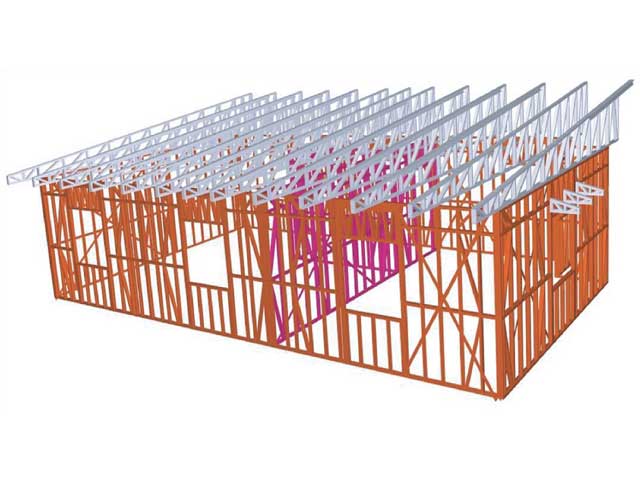
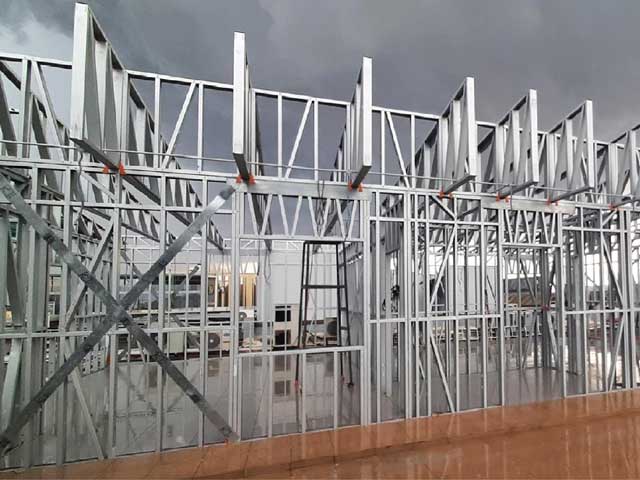
Simplicity
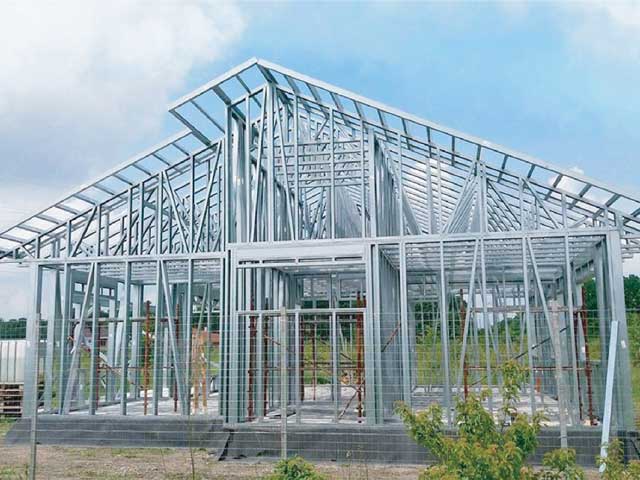
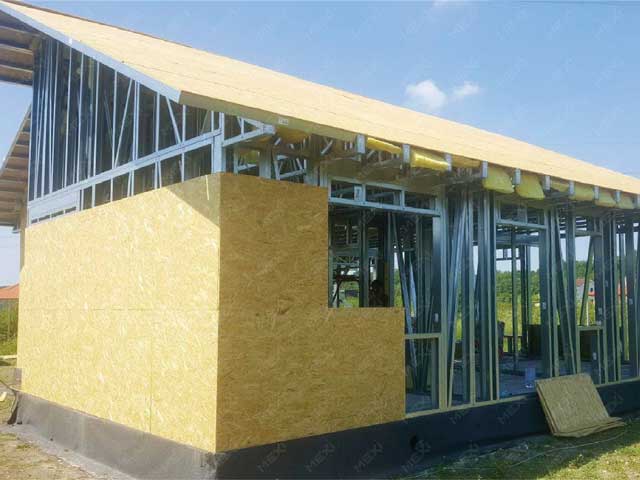
From Model to Reality
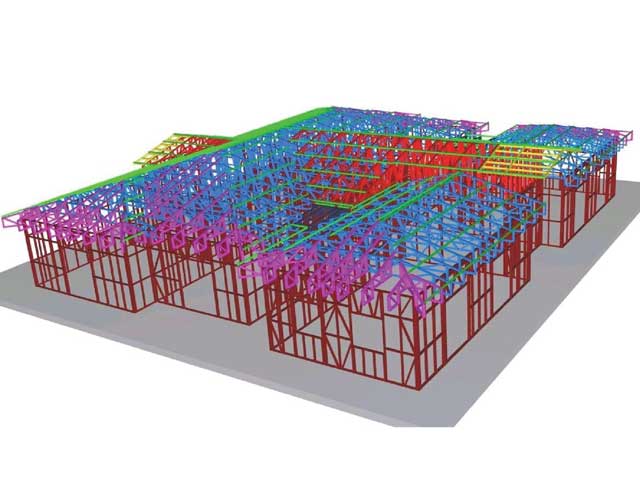
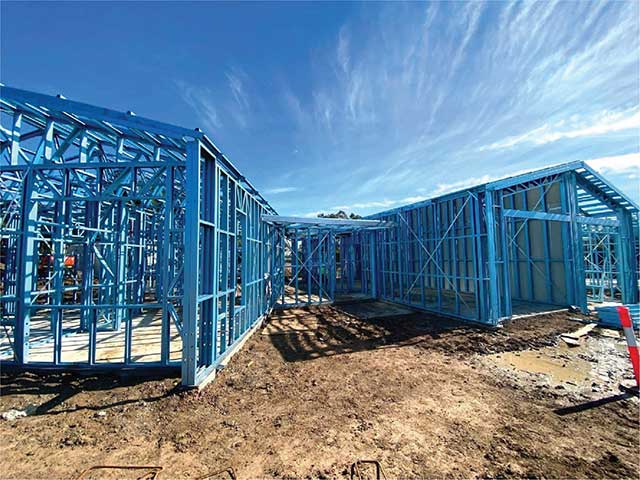
LGSF + Foam Concrete vs Precast Concrete Housing
Comparison for Kalimantan Region (Kalimantan)
| Category | LGSF + Foam Concrete Housing | Precast Concrete Housing |
|---|---|---|
| 1. Construction Method | - Modular and lightweight - Minimal wet work - Easy to assemble with hand tools |
- Heavy concrete panels - Requires cranes and large lifting equipment - High logistics burden |
| 2. Speed of Construction | - 50–70% faster construction time - Prefabricated steel frames - Foam concrete poured on-site in 1 day |
- Slower due to curing and crane erection - Limited by joint works and wet weather delays |
| 3. Suitability in Heavy Rain | - Dry installation possible even during rain - Foam concrete is water-resistant and breathable - No curing required |
- Construction often delayed by weather - Joints vulnerable to water leakage and mildew |
| 4. Structural Quality | - Ductile and flexible under stress - No cracking due to foam absorption - High insulation value |
- Heavy and rigid structure - Prone to cracking at joints - Poor thermal insulation unless added |
| 5. Earthquake Resistance | - Lightweight and flexible - Absorbs seismic energy - Suitable for soft soils of Kalimantan |
- Heavy structure with rigid joints - Brittle under lateral movement |
| 6. Logistics & Accessibility | - Ideal for remote sites like Kalimantan - Flat-packed delivery via containers - Minimal heavy equipment needed |
- Bulky components difficult to transport - Requires wide access roads and handling cranes |
| 7. Manpower & Installation | - Semi-skilled labor sufficient after short training - Quick connections - Less supervision required |
- Skilled crane operators and riggers needed - More supervision required during joint sealing |
| 8. Cost Efficiency | - Lower foundation cost - Reduced transport and labor - Low maintenance over lifetime |
- High initial cost for transport and installation - Higher maintenance for waterproofing and cracking |
Why LGSF + Foam Concrete is Better for Kalimantan:
Built Faster: Erected in days, even during rainy seasons.
Transport Friendly: Light and modular — easy to ship by container or light trucks.
Rain-Proof: No wet curing delays; foam concrete resists mold and water.
Earthquake-Resilient: Withstands seismic activity common in Kalimantan.
Cost-Effective: Lower total cost due to reduced labor, transport, and long-term maintenance.
LGSF Housing with Foam Concrete Foundation
Higher in Quality
Faster in Speed
Enhanced Earthquake Resistance
Better Insulation






House Building






High Density Foam Concrete Pavement
Methods, Methodology, Benefits, and Application
Introduction
- Foam Concrete: Lightweight concrete made by mixing cement paste with foam.
- High-Density Foam Concrete: Density range 1000–1800 kg/m³, structural use.
- Applications: Pavements, void filling, slope stabilization, etc.
Foam Concrete Pavement Benefits
- Reduced dead load on subgrade
- Excellent thermal insulation
- High workability and flowability
- Faster construction timelines
- Minimal shrinkage and settlement
Material Composition
- Cement: OPC or blended
- Foaming agent: Protein-based or synthetic
- Water: Potable
- Sand (optional): for >1400 kg/m³ density
- Additives: Plasticizers, retarders if needed
6-Month Project Schedule
This schedule is developed based on the provided project scope for the housing project (G4 type, 50 units) with Light Gauge Steel Framing (LGSF). The lead time is 7 months, including 1 month for preparation and 6 months for installation.
| Month | Activities / Milestones |
|---|---|
| Month 1 | Preparation: Mobilization, site survey, site office setup, material procurement |
| Month 2 | Wall partition works (GRC, concrete foam, LGSF) |
| Month 3 | Roof structure installation, ceiling works |
| Month 4 | Floor finishes, door & window installation, painting works |
| Month 5 | Sanitary & plumbing works, electrical works |
| Month 6 | Testing, quality checks, final handover |

